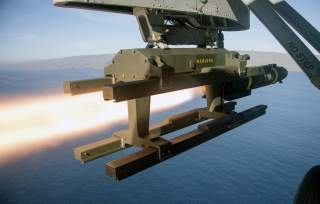The United States' New 'Ninja Missile' Chops Targets to Bits (We Have Questions)
A game-changer or just some really cool marketing?
U.S. forces reportedly killed a senior jihadist leader in Syria. While such strikes are typically carried out by drones and not so unusual, this particular strike used a new type of "ninja" missile. These missiles have been reportedly been used only a few times. Designed to minimize civilian casualties, the ninja missile is a specially modified Hellfire—without a warhead. In place of explosives, razor-sharp folding blades are used to literally chop the target to bits.
Hell in a Handbasket
The Hellfire family was originally developed in the 1980s as a tank-busting, surface-to-air missile designed specifically to counter armor. Several variants are used today, including fragmentation, incendiary, and high explosive anti-tank, or HEAT. The Hellfire missiles weigh in the 100 to 110 pound range, including a 20-pound warhead and are guided through a millimeter wave radar seeker, or by laser.
Years after their development, Hellfire missiles have become the armament of choice in the war on terror, and are often used on Reaper and Predator drones in strikes against militants in crowded, urban environments. The relatively small 20-pound warhead is crucial in these environments, where unnecessary civilian casualties or infrastructure damage could be detrimental to long-term mission success. Still, an explosion, regardless of size, runs the risk of civilian casualties. So how could a missile be improved for greater precision and pose less risk to civilian bystanders?
Chop-Chop
The R9X was developed to answer just this question. The R9X Hellfire variant is outwardly quite similar to the other Hellfire variants—except that it paradoxically isn’t equipped with an explosive warhead. In the missile body, where explosives would normally be located, are six razor-sharp blades.
The R9X missile relies on kinetic energy instead and has been described as an anvil falling from the sky—a 100-pound anvil, traveling nearly 1,000 miles an hour. These six blades pop out of the body of the missile moments before impact, creating a disc of destruction capable of chopping up people to bits and slashing through cars and other unarmored targets. It is highly accurate as well. The R9X reportedly has a “left seat, right seat” capability, wherein a car passenger could be killed and the driver, as well as other passengers, would be unharmed.
The R9X variant has been used before, albeit very sparingly. In 2017, Abu Khayr al Masri was killed (also in Syria’s Idlib province) by a drone strike. Photos from the strike show the characteristic intact glass and lack of burns, consistent with the R9X.
The R9X was reportedly used most recently in the Idlib province in Syria to kill an al-Qaeda offshoot leader as he was traveling in the region by car. In a series of separate photos posted to social media, the windows of the targeted vehicles are not blown out but mostly intact. Flammable components such as the tires and interior are also intact, illustrating the non-explosive nature of the R9X. In photos from a different R9X strike, long cuts can be seen, outlining where the missile blades sliced straight through the roof and frame of the cars.
Mission Flexibility
Due to the reduction in civilian casualties and collateral damage, the R9X offers greater flexibility to commanders and drone operators. Rather than being constrained by worrying about civilian casualties, the R9X allows shots to be taken that would be risky using a conventional Hellfire armed with explosives, since the R9X was designed to mitigate these risks.
Although not perfect, the R9X is an innovative solution that increases mission flexibility and minimizes civilian casualties when used in tandem with up-to-date intelligence.
Caleb Larson holds a Master of Public Policy degree from the Willy Brandt School of Public Policy. He lives in Berlin and writes on US and Russian foreign and defense policy, German politics, and culture.

